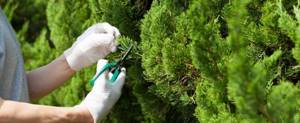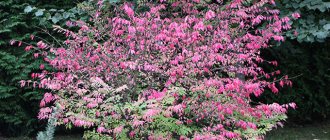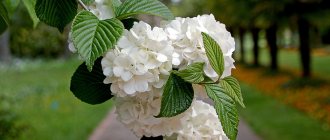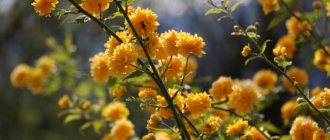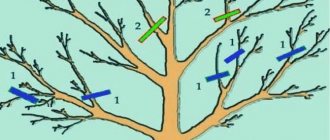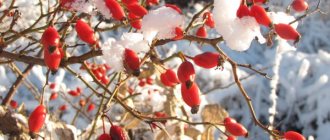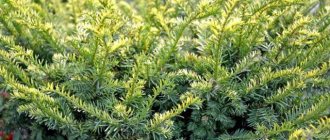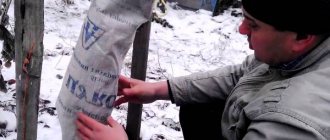Category: Growing and care Reading time: 8 min · Views: 17,767
Thuja is a beautiful coniferous plant for decorating a private yard and estate as a hedge and an element of landscape design. Along with juniper, larch and spruce, thuja has gained popularity among gardeners. In order for the tree to reveal all its decorative potential, it is necessary to carry out pruning in time to form the crown. Pruning thuja depends on its variety and purpose of the tree. Let's consider the issue in detail.
Is it possible to trim thuja
Coniferous plants need to be pruned periodically. Thuja performs a decorative function only if it has been given a certain shape. The bush can be left unpruned and it will grow well. But in this case it will not fit into the landscape design.
In Russia, as a rule, the western variety of thuja grows
Thujas are fast-growing coniferous perennials. They tolerate pruning well, accompanied by the separation of excess shoots. Experienced gardeners trim thuja in the spring as a mandatory procedure for caring for the plant.
Shapes and Figures
The forms of pruning thuja can be very different. Mostly geometric shapes are used in garden plots. When choosing a configuration, the natural appearance of the tree must be taken into account, so some silhouettes are not suitable for certain varieties.
Before trimming thujas, you must consider the following recommendations:
- The “Smaragd” variety is considered universal and can be cut in almost any way, and in case of an error it is very quickly restored. Most often, it is given a pyramidal or cone-shaped silhouette, and is also shaped in the form of a ball on a leg or animal figures.
- Columnar varieties “Columna” and “Fastigiata” are suitable for strict forms.
- Trimming the thuja occidentalis "Brabant" is most often done in the shape of a pyramid or cone.
- Dwarf "Vudvari" and "Dannika" are easily converted into a ball.
Related article:
How to grow thuja from a branch

How to cut thuja in one way or another is described below.
Cone
Before cutting the thuja into a cone, you need to prepare 3 wooden planks, the height of which will be slightly larger than the tree itself. Next, the work algorithm should be like this:
- the planks are installed close to the crown at equal intervals and the tops are fastened to form a kind of hut;
- branches that make their way between the slats are cut off;
- Having processed the sides, the “hut” is removed and the lower part is cut off.
Sometimes the above haircut option is modified by turning the tip of the cone down. Such a figure has an unfavorable effect on the plant, since its lower part always remains in the shade and does not receive enough sunlight.
Candle
The difference between a candle and a cone is that its top is not sharp, but cut off. To figure out how to properly trim a thuja in the form of a candle, you need to slightly change the arrangement of the strips from the previous description and increase their number to four.
Related article:
How to propagate and root boxwood
The result should be a frame of four planks located parallel to each other. The cutting process itself is carried out in a similar way.
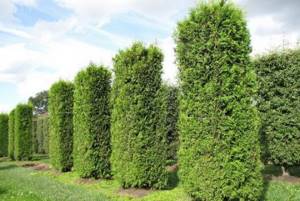
Pyramid
To trim thuja with a pyramid, the algorithm for creating a cone is also taken as a basis. The only difference is the number of strips used. You can take as many of them as there should be ribs on the pyramid.
During the work, the crown is trimmed on all sides at once. The result is an original symmetrical figure with several edges. The more there are, the more elegant the tree looks.
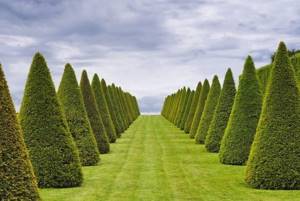
Spiral
The spiral silhouette looks interesting and unusual, but many people refuse it, considering it difficult to execute. Although this kind of pruning is quite simple. Before properly trimming the thuja with a spiral, a strong rope is attached to the top, wrapped around the surface of the crown and, reaching the bottom, firmly secured to the ground.
Related article:
Varieties of juniper with photos
Further work is performed in this order:
- use scissors to cut the needles along the top, focusing on the turns of the rope, creating a base;
- then the branches located inside are trimmed;
- Having created the desired figure, the rope is removed.
The main advantage of this pruning is the variety of types of spirals that you can change yourself.
Ball
When choosing a spherical silhouette, you need to consider which thujas can be cut this way. The easiest way is to create a ball from low varieties, which do not have to be shortened too much, since you can cut the thuja in height by no more than a third of the total volume.
Before cutting a spherical thuja, cut off its top and leave it for some time to build up the crown, which, after trimming the top, will begin to actively grow in width. After this, the branches that extend beyond the intended figure are simply trimmed.

Topiary
Curly pruning of thuja (topiary) is becoming increasingly popular as it allows you to create a wide variety of shapes. For it, a strong wire frame of the desired shape is prepared and installed around the seedling. As the plant grows, branches extending beyond its frame are cut off, and when the figure is fully formed, the frame is removed.
Related article:
The thuja is drying up. How to help
This haircut has several advantages. It has an original appearance, can have any shape, and does not subject the tree to severe stress. The downside is the duration of formation and the possibility of installing the frame only simultaneously with planting the seedling or at an early stage of its development.
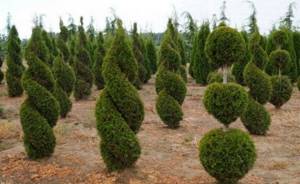
Required Tools
Before considering the instructions for cutting thuja for dummies, you need to prepare for the procedure. The main point is the preparation of the instrument.
To trim the bush and give it the desired shape, you will need sharp pruning shears. Use it to trim dry branches. Garden shears are also used for curly pruning. Thick branches on the thuja, if necessary, are removed with a sickle.
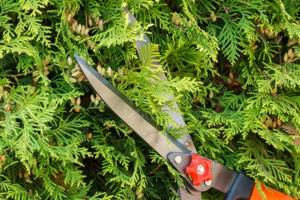
To form a crown, you need to purchase high-quality pruners or scissors. Important! When carrying out work, be sure to protect your hands from sharp branches. To do this, wear thick gardening gloves.
Before cutting the thuja, the tool must be sharpened well. If it is not sharp, the procedure will become labor-intensive. In addition, there is a risk of damage to the plant.
Tools for work
To carry out the work, no special equipment is required, since you can prune thuja beautifully with ordinary pruners and garden shears. Each of these tools has its own purpose:
- pruning shears are used to trim dry branches and excess shoots inside the crown to thin it out and improve air exchange;
- Using scissors, the plant is given the required shape by trimming the needles.
Related article:
The thuja is drying up. How to help
There are no special questions when choosing a pruner. Scissors can be used manual or electric. Each gardener has his own preferences, but if there are a lot of trees, then electric ones will work faster and easier. For processing 3–5, it is better to use mechanical scissors, since cutting thuja by hand will be much more accurate and accurate.
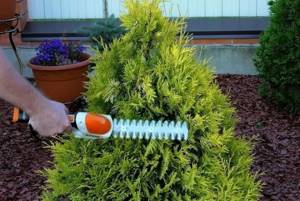
Additionally, you will need a small ax to remove thick branches. All tools should be well sharpened to reduce injury to plants.
When to prune thuja: in autumn or spring
There are no fundamental requirements for the timing of haircuts. The procedure for forming thuja can be carried out both in spring and autumn. Many gardeners prefer to trim the plant as needed when it has a large number of branches that disrupt its shape.
Pruning thuja in autumn
It is recommended to carry out cutting with the simultaneous formation of bushes at the end of August. During this period, the plant begins to prepare for the upcoming winter.
Important! Over the summer, the thuja grows up to 25-30 cm. In winter, a lot of snow sticks to the excessively long branches, under the weight of which the plant is subject to deformation.
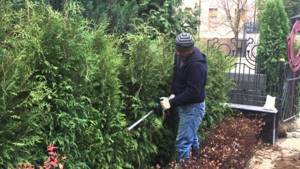
You can cut thuja both in spring and autumn.
You can prune thujas in early or mid-September. An important condition is that after cutting there should be at least two weeks left before the expected cold snap. Otherwise, the damaged branches will not have time to restore normal sap flow and may die.
How to prune thujas in spring
At the end of February or at the beginning of March, it is recommended to prune the bushes for sanitary purposes. The exact duration of the procedure depends on the climatic characteristics of the region.
If the plant was closed for the winter, it must first be opened. After this, the bush is left for several days so that it begins to straighten. After 2-3 days, a haircut is carried out.
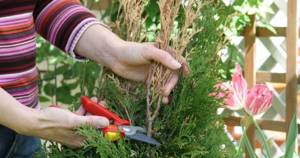
Do not cut branches immediately after rain
Yellowed or dried branches are trimmed from the bush. At the same time, it is given the desired shape to complement the landscape.
Trim time
Maintaining the plant in optimal condition depends not only on correct pruning as such, but also on choosing the appropriate period. For coniferous trees it will be significantly different from fruit trees. The reason for this is the physiological characteristics of the family.
Let's consider when to trim thujas:
- In spring, the bud breaking phase usually occurs 10 days after the average daily temperature has strengthened at +10 degrees. The flowering phase begins depending on the region: the first half of May or April, early June. If you remove excess branches before buds open and flower, you increase the risk of stopping the growing season. This technique is used only to save the current dimensions of the tree. To obtain growth, be sure to wait until the thuja fades.
- The second optimal period occurs in the autumn, at the end of August, at the beginning of September. The purpose of this event is to prepare the plant for wintering. Particular attention should be paid to long branches that may break off due to snow.
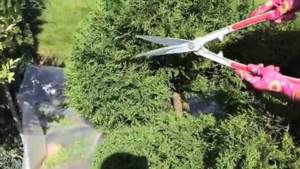
Features of cutting some varieties
Pruning must be planned in advance. To ensure the desired effect, you need to take into account the varietal characteristics of the shrub.
For example, spherical types of thuja need to be pruned regularly. Otherwise, they become deformed and can no longer be used as an independent landscape decoration.
Many thujas are used to make hedges. They need to be trimmed regularly to keep them at the same height.
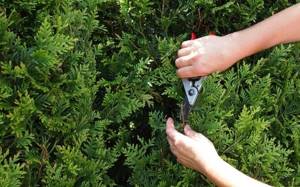
Sanitary pruning is carried out 2 times a year
Most varieties of thuja have a good appearance, even if they are not pruned. They maintain a beautiful shape for a long time, decorating the area. However, a sanitary haircut is still required, as it involves the removal of dry shoots.
How to trim thuja in a hedge?
The choice of thuja varieties for hedges depends on the required height, density and shape of the crown, and the color of the needles. Thuja occidentalis is best suited: varieties Brabant, Smaragd and Fastigiana.
When making a hedge, you should not wait until the tree reaches the required height; it should be pruned from the first years, and the green wall should be formed gradually. The top of the fence is made narrower than the bottom.
For a smooth hedge and uniform size of plants, special devices are used:
- templates;
- vertical racks;
- mesh with large cells;
- leg-split.
Video: trimming a thuja hedge
Thuja pruning forms
Trimming shrubs is not difficult if you follow simple recommendations. First of all, you need to choose a suitable form for the plant so that it matches the landscape features of the site. It is necessary to take into account the age, height of the bushes and growth rate.
To trim thuja, perform the following steps:
- Inspect the crown of the plant to identify problem areas.
- Removing unnecessary branches.
- Crown shape correction.
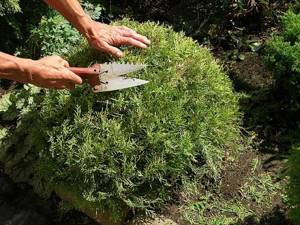
Thuja is pruned based on the natural shape of the plant. Obviously, it is not advisable to make spherical shrubs from a pyramidal or cone-shaped thuja.
Tips and warnings
For the procedure to be successful, several mandatory rules must be observed. Then even inexperienced gardeners will be able to trim the thuja and give it a beautiful shape for an ornamental shrub.
Basic recommendations:
- It is forbidden to prune young plants less than a year after planting in the ground.
- Shrubs are trimmed on each side.
- Dry branches need to be cut off completely, at the very base.
- Remove shoots that lack needles.
- There should be no holes in the crown after cutting.
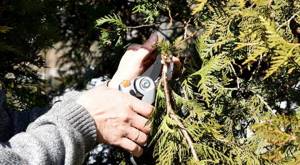
Beginning gardeners are advised not to give complex shapes or make green sculptures. First, it is advised to master simple geometric shapes: pyramids, cones, cylinders. In the future, as you gain experience in decorative pruning of thuja, it will be possible to complicate the process.
One of the most difficult options is a topiary haircut. It is used in the manufacture of green compositions and hedges.
Step-by-step curly haircut of thuja
Unlike sanitary pruning, shaping can be repeated regularly. Some types of shrubs need to be pruned periodically because the branches grow back very quickly and cause deformation of the plant.
To find out how to properly carry out a topiary haircut, you can watch master classes from experienced gardeners:
How to cut a thuja with a spiral
This option is very popular among landscape designers. The spiral shape is a unique decoration of the site. Tall thujas with a straight trunk are ideal for such a figure. If the shrub has several bases, they are fastened together.
For the procedure you will need:
- gardening scissors;
- long rope;
- spray paint.

Initially, the plant is sanitized, removing everything unnecessary from it. In the future, using a rope or spray paint, you need to outline the lines of movement of the spiral. This will allow you to see the areas of the plant that need to be cut to give the desired shape.
Important! A spiral figure is created in several haircuts. During the first, the shape is outlined, and with subsequent trimmings it is deepened.
The spiral should be symmetrical so that the plant looks attractive from all sides. When creating such a figure, the top is usually left, but some gardeners prefer to remove the upper part of the crown.
How to cut a thuja with a cone
This form of plant is recommended for beginners due to its simplicity. For cone cutting, a wooden or wire frame is used. It is made in the form of a triangle with the base located at the roots of the bush. The use of such a frame allows you to give the correct conical shape.
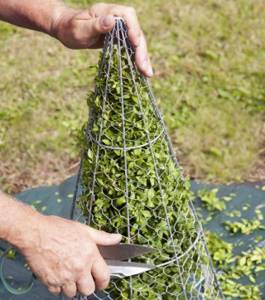
The procedure can be performed using garden shears, pruners or hedge trimmers
Trimming is carried out evenly on each side. Periodically, the gardener should move away from the bush and check for deformed branches. After creating a cone-shaped figure, it is enough to periodically trim the hair for correction. Then the plant will not have time to send out shoots that violate the geometric shape.
Globular thuja haircut
This pruning option often causes difficulties even for experienced gardeners. It is difficult to give a shrub the shape of a regular ball due to the need to maintain proportions. There are several ways to solve the problem.
Among them:
- use of wire frame;
- using a hoop as a template for a haircut;
- using garden shears with rounded blades.
Many varieties of thuja are naturally spherical. Therefore, these varieties should be given a round shape.
Popular spherical varieties:
- Danica.
- Teddy.
- Globoza.
- Golden Globe.
- Hosery.
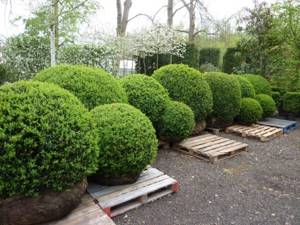
Such thujas are best suited for giving the shape of a ball. Because of their natural configuration, they are much easier to round than other varieties of coniferous shrubs.
Topiary haircut
The crown of the thuja is excellent for forming complex geometric shapes. Making green sculptures from bushes is the main direction of topiary cutting.
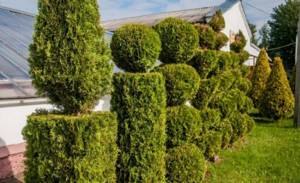
To trim trees, it is advisable to choose cloudy weather
This procedure will require a frame. It repeats the shape of a certain figure. Having put it on the bush, it is enough to trim off the excess branches. The result will be a decorative figure. Having given the bush the required shape, the frame is removed. Preventative haircuts are repeated regularly.
There is another option for making green sculptures and hedges. The frame is put on a young plant before it has grown. The bush will acquire the desired shape as it grows, after which pruning will be required only for correction purposes.
Horizontal crown formation
This option will certainly appeal to those who do not want to deeply prun the plant due to potential harm. Horizontal formation is carried out on young shrubs that have not yet grown to a constant height.
The main way to change direction is to limit the ability of branches to grow upward. To do this, stretch a wire that prevents the vertical growth of shoots. As a result, the branches are forced to turn and grow in a horizontal direction.
The wire is attached to young thujas at the end of winter or early spring. The restrictor must be removed in the fall. At the same time, you need to trim the thuja in height to remove branches located above the level of the wire.
Another method of horizontal shaping is gartering. The bases of the bush are tied with a rope to supports that are fixed in the ground. Usually their function is performed by metal tubes or wooden poles. This method is best suited for thujas whose height does not exceed 60 cm.
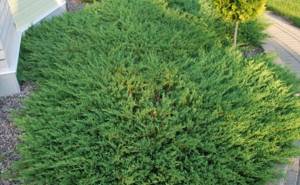
If you cut off the top shoots, the perennial will grow wider
Some gardeners advise tying weights to large branches, which will lead to a change in the direction of growth. This method is not recommended, since heavy objects fixed to the bush can cause damage or severe deformation of the plant.
Arborvitae haircut
Do not strive for curly haircuts if you do not have the time to carefully maintain the topiary outlines. Natural contours look harmonious. A sanitary procedure once a year is enough. A systematic haircut is needed when you are passionate about the idea of an interesting design solution in order to implement it at the dacha.
Find out more about how to water thuja efficiently.
Follow the basic rules when cutting, and the crown of the tree will be spectacularly transformed, gaining volume and density:
- You can trim the strongly protruding branches of the seedling at the time of planting, but give it shape only the next season.
- Remove dry branches completely, and remove diseased branches with browned needles gradually. Do not leave stumps from such branches.
- To create an outline, mark the cutting areas.
- Do not cut branches short - stress will do more harm to the plant than good. The guideline is a third of the length or from 10 to 30 cm of new greenery according to the varietal characteristics, but not more than 30% of the green mass for pruning.
- Bare branches will not grow greenery like deciduous plants. Such branches will dry out, so they are removed completely or the greenery is not trimmed too much.
- Trim, retreating 1-2 cm to the bud - this way it will not dry out while the cut heals.
- The position of the branch and the direction of growth of the future shoot is important: cut, focusing on the outer bud, if the branch is directed upward. Trim the one lowered to the ground, taking into account the space for the development of the internal bud.
- When pruning, do not rush: it is better to correct what has not been trimmed later than to expose the bush - openings in the crown that are not overgrown will disfigure the thuja.
- Avoid leaving bare shoots in the crown. This will lead to the formation of bald spots, and the integrity of the composition will be compromised.
- Walk away often, assessing the results from a distance.
- Perform the procedure regularly, the shape of the topiary needs support. Without adjustments, the shrub will regain its original appearance by the end of summer.
- Add the length of the branches, reducing the amount cut by 5 cm with each subsequent pruning - the tree proportionally increases in volume.
- To thicken the inside of the bush, trim it from the inside, maintaining its size.
- Trim a small area at a time, then move on to the next section.
- Decorative pruning along an already formed crown will require cutting off only part of the annual shoots.
- Be careful with radical pruning: if the tree has not been trimmed for many years, remove some of the mass little by little. Thuja cannot tolerate strong shortening and may die.
- Trees in shade do not require thinning of the sparse crown. Carry out only sanitary measures for them.
- Consider atmospheric conditions: avoid cutting in damp and rainy weather, as this attracts pests and diseases. Haircutting in bright sunlight after rain will lead to the appearance of brown bald spots and yellowed areas caused by moisture evaporation and sunburn. Expect cloudy, dry weather.
- Do not rely on the eye, stock up on blanks for shaping: twine to control the level, arches, arcs, rectangles made of wire.
- Don't try to tackle complex figures immediately; For beginners, experience with simple pruning will help you easily create tiers or spirals.
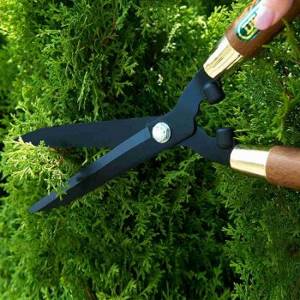
Practice will help you avoid mistakes. It is better to hone your skills on natural pyramidal or spherical varieties by sparse pruning without correcting the contour. Thuja occidentalis will calmly survive the removal of some healthy branches - air circulation in the crown will only benefit it, protecting it from pests. And spherical varieties, for example, do not even need thinning, effectively increasing the density of green cover.
Also find out what is better than thuja Smaragd or Brabant.
After cutting, the vegetative processes are suspended, but the sleeping buds wake up to begin to grow. They will fill the crown with fresh herbs within 2 months. To activate this process and support after stress, feed the thuja in the spring with the Kemira Universal complex fertilizer (100 g per 1 m²). In summer, fertilizing is not needed, but spraying with the Epin Extra stimulant is recommended; after 10 days, repeat the same procedure with Zircon.
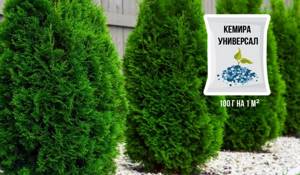
Reduce the amount of mineral and organic fertilizers if pruning is carried out more often than required by the variety. With rapid fouling, it is also necessary to reduce the amount of fertilizer applied.
Be sure to water the trees immediately after cutting: add at least 10 liters of water to each young trunk; for old ones, it is advisable to increase watering to 50 liters. Cuts made correctly with a sharp instrument will close on their own. Resin with high rates of healing components is released in large quantities by a healthy tree.
Wounds after removing large branches require treatment if the plant is weakened. It is permissible to use putty for fruit species: “RanNet” paste, “Sadovnik” garden varnish, “Fasco” - although these products do not contain pine resin, they are capable of sealing the cut. Bio-balm “Robin Green” and var “Zhivitsa”, which contain resinous substances, will compensate for its deficiency.
in autumn
In the fall, the tree is pruned, combining preventive care with shaping care. The main condition is the absence of humidity.
Important! If you completely remove all of last year's growth, the thuja will not bloom and will greatly slow down its growth rate.
Preparations for winter should begin from the end of August for cold regions and from September in the south, according to the following plan:
- Remove all damaged and dried shoots.
- Inspect the space near the trunk; when thickening, cut off healthy branches to allow air to enter.
- Apply garden varnish to poorly healing areas of large cuts.
- Carefully inspect the plant: a third of the length of the branches that have grown over the summer should be removed; they will break off under the weight of ice and snow.
These manipulations will not only correct the shape, but also protect against heavy snowfalls. Do not overdo it with the intensity of pruning, because flower buds are formed in the fall.
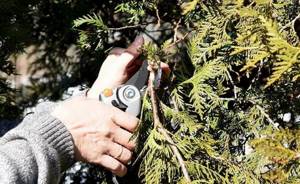
in spring
In March, the cover must be removed so that the plant can straighten its branches. Warm climates without frost allow for pruning in mid-February, but this procedure will inhibit growth. Before the buds open, do not prune old branches if thinning the greenery is not included in the plans, otherwise the growing season will stop, and the buds laid on the tops in the fall will not bloom next season.
Find out more about how to propagate thuja at home.
To avoid mistakes in the timing of spring pruning:
- Focus on an average daily temperature of +10°C for 10 days, then the buds are ready to bloom. Flowering begins in mid-April in the southern regions and shifts to the second half of May and mid-June in the north.
- To achieve active growth, postpone pruning until the thuja has finished blooming, and only then remove the frozen shoots.
- Topiary cutting is best done at the end of May after flowering. If you move it by June, the thuja will not increase the volume of habit necessary for wintering.
- A warm climate accelerates vegetative processes, so with early warming, cutting is carried out from mid-April.
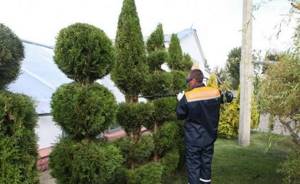
In summer
It happens that the best period for shaping is missed, then simply carry out sanitary procedures during the first month of summer and thin out the crown to make the heat easier to bear. From June and throughout the summer, continue adjusting the crown with periodic removal of young needles, light pinching (pinching off the tops) and mandatory watering.
Is it possible to trim the top of a thuja?
Coniferous shrubs grow very quickly. In 1 year, one thuja can increase by 30 cm or more. Because of this, the question arises about the need to remove the top. Trimming the upper part of the crown is not only possible, but also necessary. The procedure promotes the appearance of new shoots.
Trimming the top is especially important if the thujas are planted as a green hedge. The procedure will be needed to level the plants, otherwise the overall composition will be disrupted.
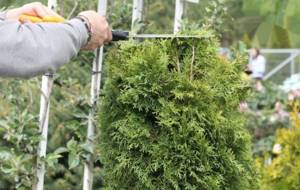
If the perennial overgrows quickly, you need to reduce the amount of fertilizer used.
Important! The top needs to be trimmed at least once every 2 years. It is best to carry out this procedure simultaneously with sanitary trimming of the bushes.
It is also necessary to trim the top part of the bush for another reason. An overly abundant and dense upper crown can result in the lower shoots not receiving enough sunlight. This will harm the plant and may cause a change in the color of the needles, which will also affect its decorative qualities.
Types of haircuts
The frequency and technology of cutting largely depend on the purpose of such an event. On this basis, there are 2 types of haircuts:
- sanitary
- decorative
The first one is sufficient to carry out according to the above schedule to ensure normal development of the plant, remove low-quality branches and thin out the crown. To give an aesthetic appearance, a tree or shrub is pruned as necessary.
Interesting: Winter-hardy shrubs for the garden
Sanitary
Since it is mandatory to trim thujas correctly for the purpose of sanitary cleaning, the principle of performing such work must be known to everyone who has this coniferous perennial growing on their property. This process includes the following types of work:
- removal of old needles that have changed color and shape throughout the crown and in the trunk part to prevent the development of infection and the appearance of pests;
- removing dried and damaged branches to improve structure and appearance.
Related article:
We save thuja from yellowing with fertilizing
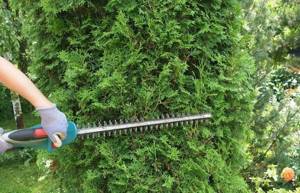
There are several principles that must be followed in order to help and not harm the plant:
- Choosing a weather-appropriate day. Work should be carried out when it is cloudy outside, otherwise the sun's rays will burn the cut areas. In addition, no rain should be expected in the next 2 days.
- Assessment of tree condition. Only healthy plants can be trimmed. If there are any diseases, they must first be cured.
- Compliance with the amount of trimming. When thinning the crown, you can remove no more than 30% of branches and needles.
Dwarf and bushy flat-branched plants are not thinned out.
Decorative
Decorative cutting of thuja is not mandatory, but it helps to significantly improve its appearance. Before carrying out such work, you need to plan how to cut the thuja beautifully so that it fits harmoniously into the overall design. In this case, the shape must be chosen taking into account the natural configuration of the crown, since this approach will significantly simplify the pruning process itself and create less stress for the plant itself.
The principles of shaping haircuts are the same as for sanitary treatment. Beginners are advised to start with simple figures and move on to more complex ones as they gain experience.
Related article:
Survive the cold without loss: 5 reliable ways to protect conifers in winter

Experienced specialists themselves figure out how to shape thuja, creating unique figures of people, animals, literary characters, and also arranging them into entire compositions. On personal plots, simple silhouettes are more often used - cones, pyramids, balls.
Care after pruning
Thuja is considered an unpretentious plant. But after the bush is pruned, it needs special attention. Additional care helps eliminate the negative consequences of the procedure. This is especially important if a large number of living branches are pruned.
Mandatory procedures after haircut:
- Abundant watering.
- Removing weeds.
- Loosening and mulching the soil around the bush.
- Fertilizer feeding.
Small thujas need 10 liters of liquid. If you cut a large specimen, it needs 30-50 liters of water. After removing the branches, the rate of liquid evaporation increases. Therefore, abundant watering is needed every week for the first month from the moment of cutting.

After pruning, trees can be treated with a growth stimulator.
After this, the soil is loosened. The procedure prevents fluid stagnation. Compost, crushed bark and wood chips are used as mulch for thuja.
If thick living branches have been cut from a bush, the removal areas should be covered with crushed coal or peat. Thanks to this treatment, the risk of pathogenic microorganisms entering the cut area is reduced.
You need to feed thuja with mineral or organic fertilizer only if it was pruned in the spring. In the autumn, it is impossible to feed the plant, as otherwise the plant will not have time to prepare for wintering.
Immediately after cutting, it is forbidden to spray the bush against pests or diseases. Toxic substances can get into the cut areas and trigger the process of death of the affected areas.
Pruning rules
Having planned the operation, you need to familiarize yourself with the recommendations on how to properly trim thuja:
- The average annual growth is 10-20 cm, so there is no need to shorten the shoots too much. When forming a certain geometric figure, no more than 2-3 years of growth is removed.
- Massive pruning is carried out in several stages, since the loss of branches is stressful, which can weaken the immune system and cause various diseases.
- Spring pruning necessarily requires sanitary measures - removing diseased and dried shoots, thinning the crown for air circulation.
- The procedure is coordinated with the weather. There should be no rain on the day of the event, or in the near future. Humid air contains more pathogens that can settle on plant cuttings.
- The branches should not be exposed excessively - coniferous trees will not be able to grow new green mass on them, as a result of which they will soon dry out.
- The cut is made at a height of 1-2 cm from the kidney. This will prevent it from dying off while the wound is healing.
- The location of the cut is determined by the position of the branch and the direction of its growth. So, shoots raised up are cut off to the outer bud, and shoots that are lowered are cut off to the inner bud.
